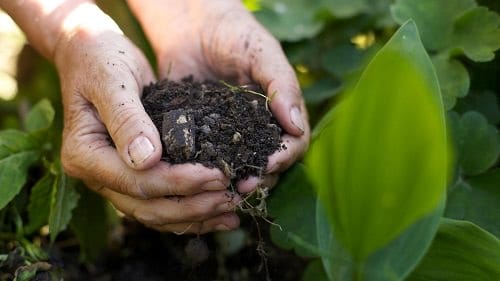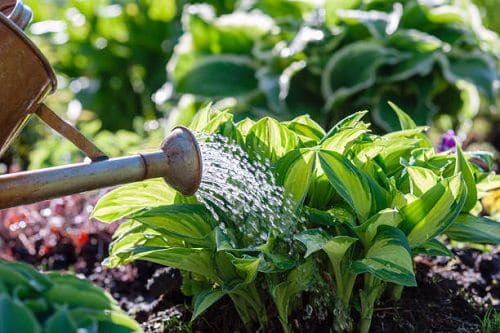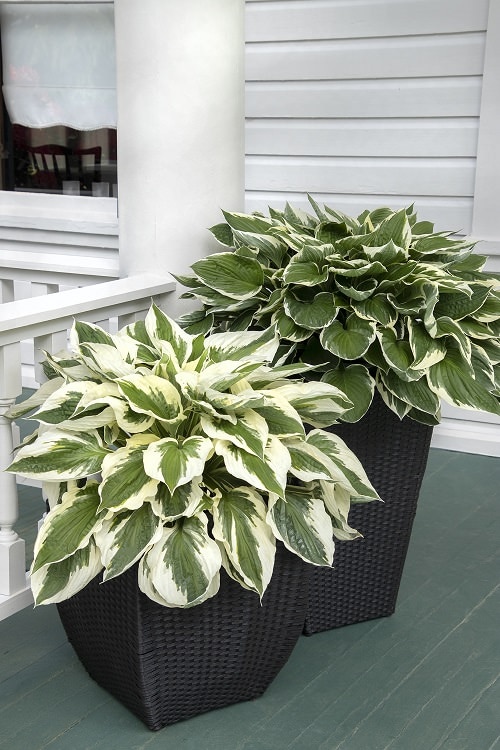These Hosta Growing Ideas, Tips, and Tricks will make planting this amazing foliage plant a whole lot easier than ever before.
You can dedicate an entire garden to hostas, and that might still not be enough, thanks to all the varieties it comes in with various combinations of leaf color, shape, size, and texture! As this plant is so popular, most gardeners want to know everything about Hosta Growing Ideas, Tips, and Tricks, and this article will surely make you a hosta expert!
Check out our article on growing Hostas bold and beautiful here
Propagating Hostas

By Division
- It is the most widely used method of propagation.
- Check that no shoots are growing in the center of the plant. If there is a bare area in the center, your hosta is mature enough for the division.
- Dig out the plant carefully, using a shovel, and remove the excess soil by washing roots. Use a cutting tool to divide the clump.
- Water thoroughly after planting as root size decreases considerably after division.
- The best time to plant divisions is spring.
By Seeds
- Check if the seed pod is ready to harvest by its color, and collect them when they turn brown.
- Keep the pod in an open plastic zip bag. The pod will release seeds on its own when it becomes dry.
- You can either plant those seeds directly or store them in a cold and dry environment.
Best Soil For Hostas

Hostas thrive in rich soil with good drainage. Adding organic matter to the soil work wonders for the growth of the plant. Compost, leaf mold, well-rotted manure, peat moss, or composted pine bark are some of the great options for soil amendment.
Sunlight Requirements
Hostas do not tolerate direct sun for a prolonged period. A spot that receives indirect bright light is perfect. The trick is to locate them at someplace where they can receive direct sunlight either in the morning or evening time, and shade all day, especially the afternoon. Knowing about the type of hosta you are going to plant will also be helpful.
Watering

With hostas, you have to make sure that you are never letting the soil go dry completely. A straightforward way to know that you are not providing enough water to the hostas is by checking the foliage. If you notice that it lacks luster and water content in leaves and turning slightly brown, then it is an indication that hostas need more irrigation.
The best time to water hostas is in the morning, as the plants will remain hydrated throughout the day. Sprinkling mulch around the plants also helps to retain moisture. If the weather is warm and humid, you should avoid wetting the foliage to prevent diseases.
Fertilization
Hostas need fertilizers in the initial growth stage, but it is not mandatory. Once they are established, they don’t require much fertilization as the difference in growth rate is not noticeable after that, but they do benefit from the yearly topdressing of cow manure.
However, the best time to fertilize is in spring when the new growth emerges, and probably a couple more times afterward during the growing season with a balanced granular fertilizer like 10-10-10. But avoid feeding the plant after late summer or early fall.
Hostas also appreciate the occasional application of Epsom salt–it makes them lush and healthy. For more information, read this article.
Pests and Diseases

Slugs, snails, and cutworms most commonly attack hostas. They can be handpicked, or you can wash them away with a spray of water.
- Large spots having dark borders on the hosta leaves indicate Anthracnose. You can fight this easily by spraying fungicide.
- Using too much mulch can cause Sclerotium Blight. White masses on the plant and brown, whistled leaves are a sure sign of it. Remove the mulch manually to prevent this.
- Too much watering and stagnant water can cause crown rot. Keep watering in check to prevent this.
Container Growing Tips

- The size of the container depends on the type, variety, and size of the plant. Small or dwarf varieties need smaller containers, and bigger varieties will do good in pots ranging between 14-20 inches.
- Providing drainage holes in the container is of utmost importance.
- Locate the container in a spot where it is protected from the harsh sun.
- Water hosta plants regularly to keep the soil slightly moist. Avoid overwatering!
- As the nutrients wash away with time, boost the growth by fertilizing once in two-three months.
Care In Winters
Hostas will not remain green throughout the winters. After the first frost has passed, you should prune off the dead and decaying leaves using a pruning shear or scissors. Don’t worry, come springs, and your hostas will grow back again!
Tips on Growing Hostas Indoors

As these gorgeous plants are shade tolerant, growing them indoors is possible!
- Hostas with green foliage are more tolerant to the sun as compared to the variegated varieties. Placing them by an East-facing window would be best.
- Hosta can grow indoors if the spot is bright, receives plenty of indirect light, and have good air circulation. Avoid keeping them in the dark places.
- Using the soil-less, fluffy growing medium will keep them thriving.
- Water the plant in a way that the soil remains mildly moist all the time. Avoid wetting leaves and stems.
- You will have to re-pot them once in every 2-3 years in a 1-2 size bigger container.
- To allow them to go dormant, keep the plants in the dark and cold area with the temperature around 42°F (5°C) for 5-10 weeks.
- Some of the best varieties you can grow indoors are–Sunshine Glory, Cracker Crumbs, Frosted Mouse Ears, Patriot, and El Nino.
Growing Hosta in Warm Climates
Well, growing hosta in hot climates (USDA Zones 9-10) is difficult because they need their winter dormancy. However, you can try those varieties in containers that have a low dormancy period, usually around 30 days.
Some of the names are Hosta clausa, Hosta gracillima, Hosta kikutii, Hosta longipes, Hosta montana (southern forms), Hosta nakaiana, Hosta plantaginea, Hosta rupifraga, Hosta sieboldii, Hosta ventricosa, Hosta venusta, and Hosta yingeri. To learn more, read this informative article.


